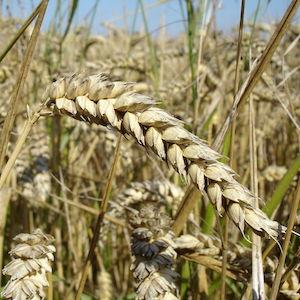One of the troubles with agriculture is the need for farmers to apply fertilizer. The plants don't soak up all of it, which inevitably results in fertilizer running off into lakes and rivers.
That's problematic not just because it is wasteful of the farmer's precious financial resources, but because it is also wasteful of the planet's finite supply of phosphorus. Worse, when phosphorus and other nutrients make their way into bodies of water, they can trigger nasty algal blooms, which kicks off a chain reaction known as eutrophication. As the algae die off, they are decomposed by bacteria that use up much of the oxygen, suffocating animals and resulting in massive fish kills. (See image, below right1.)
Decreasing the amount of applied fertilizer is therefore a goal that farmers and environmentalists should support. Now, a team of Pakistani researchers has genetically engineered a strain of wheat that should require less fertilizer.
Transgenic Wheat Is More Phosphorus Efficient
Depending on the type of soil, a phosphorus-containing compound called phytate may be in abundant supply. However, plants are largely unable to use it. The researchers turned to a fungus, Aspergillus japonicus, which produces an enzyme, called phytase, that breaks down phytate. The authors figured that this enzyme could help free up the phosphorus locked up inside phytate.
So the team inserted the fungal gene for phytase into wheat. They tweaked the gene so that it was only "turned on" in the roots, and they added another tweak that caused the enzyme encoded by the gene to be secreted into the environment. The result was the creation of wheat plants with high phytase content in their roots, some of which was oozed into the soil. The enzyme would then break down phytate and release the phosphorus, which the wheat could soak up.
When compared to control plants grown in the presence of phytate, the genetically engineered plants grew bigger and contained more phosphorus. The best-performing plant had 118% greater phosphorus efficiency than the control plants2.
Therefore, the authors successfully demonstrated that their transgenic plants could grow quite well in soil containing phytate, a condition that would be considered "phosphorus deficient" for other plants. The next step would be to conduct field trials to verify that, under real-world conditions, their plants require less fertilizer than other crops. Furthermore, they should examine how secreted phytase affects the soil microbiome and soil quality. Finally, the team should strongly consider commercialization, assuming they can find a company interested enough3.
Notes
(1) Credit: Alexandr Trubetskoy/Wikipedia
(2) The authors defined phosphorus efficiency as the ratio of the mass of the wheat plant grown in phytate to the mass of the wheat plant grown in inorganic phosphorus (a form that is readily available to plants). The control plants grew better in inorganic phosphorus than in phytate, while the opposite was true for the genetically engineered plants.
(3) A genetically engineered pig (called Enviropig) expressed phytase in its saliva. The idea was that the pig would absorb more phosphorus and excrete less in its feces. Unfortunately, the pigs didn't receive much industry support, so the researchers killed all of them.
Source: Samreen Mohsin, et al. "Extracellular Secretion of Phytase from Transgenic Wheat Roots Allows Utilization of Phytate for Enhanced Phosphorus Uptake." Molecular Biotechnology 59 (8): 334-342. Published: 30-June-2017.




